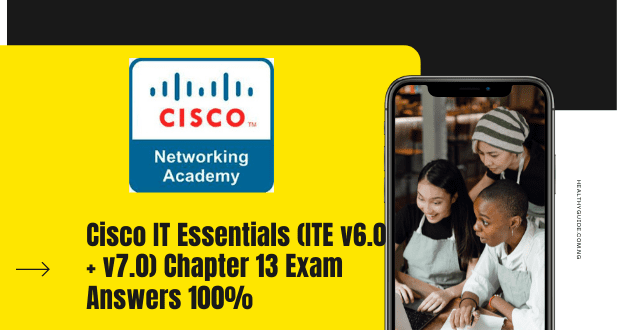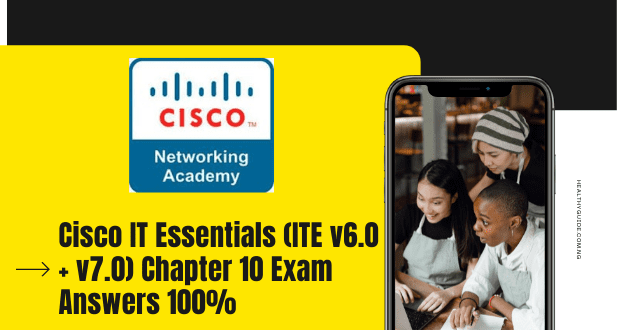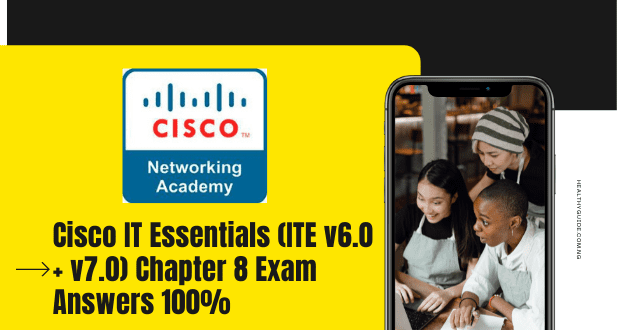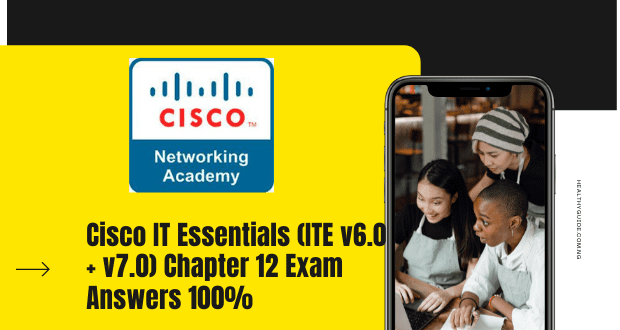Cisco ITE v7.0 Certification Checkpoint Exam #1 Chapters 1-4 Exam Answers
Cisco ITE v7.0 Certification Checkpoint Exam #1 Chapters 1-4 Exam Answers – Join the growing IT workforce of tomorrow. Learn about the Cisco Networking Academy curriculum, learning platform, support & training.on healthyguide we provide solution to almost all exam answers today we provide anwers to cisco Certification exam 1 – 4.How to find ANSWER/QUESTION: Press “Ctrl + F” in the browser and fill in whatever wording is in the question to find that question/answer.
NOTE: If you have a new question for this test, please leave a comment in the form below with the question and multiple-choice list. We will respond to your questions as soon as possible. Thank you very much! Your contribution to the website is greatly appreciated.
Also check :FREE ENVATO ELEMENT ACCOUNT HERE
Cisco ITE v7.0 Certification Checkpoint Exam #1 Chapters 1-4 Exam Answers
1. A user is building a custom computer system and is trying to decide on components for the new system. The user does light to medium graphic design, programming, and gaming. Which two components would be appropriate for this type of machine? (Choose two.)
- dedicated video card
- integrated CPU
- SSD
- high speed mechanical drive
- maximum CPU cores
Explanation: Both a gaming and graphic design computer should have an SSD and high-end video card. The computer should have a multicore CPU, but this computer does not require the maximum number of cores that a virtualization computer would need.
2. A technician has installed a new second hard drive in a tower computer, but the drive does not show up in the BIOS. What are two things the technician should check first? (Choose two.)
- The drive has been partitioned.
- The drive works in another computer.
- Data and power cables are attached.
- The drive port is enabled in the BIOS.
- The power supply outputs enough wattage.
Explanation: If the BIOS cannot detect a drive, either the port is disabled in the BIOS or the cables are not attached securely. A tower computer can typically have a second hard drive installed without any power issues. The drive cannot be partitioned or formatted until the BIOS recognizes it.
3. A user reports that when games are being played, the computer displays random blotches on the screen. What are two possible causes? (Choose two.)
- bad inverter
- loose video cable
- failing LCD backlight
- GPU overheating
- failing power supply
Explanation: Artifacts such as dots, lines, or patterns on a screen are typically caused by a failing video card, an underpowered or overheated GPU, a loose video cable, overclocked CPU, or outdated video driver.
4. A technician is installing memory into a computer and notices that there are two black memory slots and two blue memory slots. Which memory technology does this motherboard use?
- DDR4
- dual channel
- ECC
- parity
Explanation: Motherboards that support dual channel frequently color the memory slots so the technician knows to populate the same color slots with a matching pair of memory modules.
5. A user has the following requirements for a RAID drive:
It must be magnetic.
It must be fast.
It must fit into a standard tower case.
Which drive type would meet the user requirements?
- 3.5 inch 15K drive
- BD-RE
- NVMe
- SSD
Explanation: A 3.5 inch drive is commonly used in a tower computer. 15 K is commonly used to represent 15,000 rpm drives which are very fast magnetic drives. Blu-ray drives are not used in a RAID configuration. SSD and NVMe use flash memory and are not mechanical drives.
6. A company is deploying both thin and thick client computers. Which configuration step will a technician need to do on the thin clients that will most likely not be done on the thick clients?
- Install additional RAM.
- Install local applications.
- Connect the computer to the LAN.
- Connect the computer to the application server.
Explanation: A thick client is a normal corporate workstation. A thin client is usually a monitor, keyboard, mouse, and a computer with few or no ports and no hard drive. A thin client runs applications and possibly even the operating system from a centralized device such as a server. A corporate technician commonly uses imaging software to install both, but a thin client requires the technician to make the connection to an application server.
7. A technician is researching how to troubleshoot a computer that reboots randomly. The research suggests that the technician should check the computer for distended capacitors. Where should the technician look for these?
- under the CPU
- on the motherboard
- on the memory module
- within the power supply
Explanation: Distended capacitors are motherboard components that look like they are bulging. They can leak and cause motherboard issues.
8. Where would a technician use an RG-6 cable?
- when attaching a PC to a LAN
- when replacing cable TV cabling
- when connecting a display to a PC
- when attaching an external hard drive
Explanation: RG-6 is a type of coaxial cable used in cable TV installations.
9. A technician is asked to configure a laptop for LoJack. What will the technician have to do to accomplish this task?
- Enable it in BIOS.
- Install antimalware software.
- Perform special steps on the hard drive using the Disk Management tool.
- Attach a physical cable through a special hardware loop that is part of the computer case.
Explanation: LoJack is a security option that can be enabled and used to track a stolen device such as a laptop.
10. A technician needs to purchase a storage drive that both connects directly to the PCIe bus and provides reliability. Which type of storage device would best meet these requirements?
- 2.5″ HDD
- 2.5″ SSD
- tape drive
- NVMe M.2
Explanation: An NVMe M.2 device is a type of SSD that attaches to the PCIe bus without requiring SATA connectors or special drivers.
11. A user is building a new computer system. Why would the user select a straight-through cable?
- to connect a device to a wired network
- to install an EEPROM
- to diminish any electrostatic charge
- to attach an external HD
12. A user is building a new computer system. Why would the user select a 24-pin connector?
- to attach power to the motherboard
- to replace a heatsink
- to diminish any electrostatic charge
- to attach an external HD
13. A user is building a new computer system. Why would the user select two hard drives?
- to configure a RAID
- to share input devices between two monitors
- to attach a laser printer
- to attach a VR headset
14. A user is building a new computer system. Why would the user select three hard drives?
- to configure a RAID
- to share input devices between two monitors
- to attach a laser printer
- to attach a VR headset
15. A user is building a new computer system. Why would the user select a DVI to VGA adaptor?
- to attach to an analog monitor
- to connect a Bluetooth device
- to attach a laser printer
- to attach a VR headset
16. A user is building a new computer system. Why would the user select an RG-6 cable?
- to replace cable TV cabling
- to install a GRU
- to attach a laser printer
- to attach a VR headset
17. A user is building a new computer system. Why would the user select a PCIe x16 expansion slot?
- to install a video card
- to install a GRU
- to attach a laser printer
- to attach a VR headset
18. A user is building a new computer system. Why would the user select a DDR3?
- to install a memory module
- to diminish any electrostatic charge
- to attach a laser printer
- to attach a VR headset
19. A user is building a new computer system. Why would the user select a DDR4?
- to install a memory module
- to attach an external HD
- to attach a laser printer
- to configure a gaming console
20. A user is building a new computer system. Why would the user select external screws?
- to install a power supply into a PC tower case
- to attach an external HD
- to configure a gaming console
- to diminish any electrostatic charge
21. What characteristic best describes a KVM switch?
- a device that allows the use of one set of keyboard, mouse, and monitor to control multiple computers
- an input device often used to provide secure access to locations or devices by using voice, facial, or fingerprint recognition
- an input device allowing users to pay for a product by tapping their credit card or smartphone on another device
- an input device that reads barcodes affixed to most retail products
22. What characteristic best describes a projector?
- an output device used to present information from a laptop onto a screen
- an input device allowing users to pay for a product by tapping their credit card or smartphone on another device
- an input device that reads barcodes affixed to most retail products
- an input device that reads encoded information from the back of plastic cards
23. What characteristic best describes a touch screen?
- an input device that recognizes touch and pressure as instructions
- an input device often used to provide secure access to locations or devices by using voice, facial, or fingerprint recognition
- an input device allowing users to pay for a product by tapping their credit card or smartphone on another device
- an input device that reads barcodes affixed to most retail products
24. What characteristic best describes an AR headset?
- a head-mounted device that superimposes images and audio over a real world image and can provide users immediate access to information about their real surroundings
- an input device allowing users to pay for a product by tapping their credit card or smartphone on another device
- an input device that reads barcodes affixed to most retail products
- an input device that reads encoded information from the back of plastic cards
25. What characteristic best describes a stylus?
- a pen-like tool that allows input by touching the surface of the screen
- an input device often used to provide secure access to locations or devices by using voice, facial, or fingerprint recognition
- an input device allowing users to pay for a product by tapping their credit card or smartphone on another device
- an input device that reads barcodes affixed to most retail products
26. What characteristic best describes an AR headset?
- a head-mounted device that superimposes images and audio over a real world image and can provide users immediate access to information about their real surroundings
- an input device that provides verification of package delivery by digitizing a written name
- an output device used to present information from a laptop onto a screen
- an output device that uses LED, LCD, or OLED technology
27. What characteristic best describes a magstripe reader?
- an input device that reads encoded information from the back of plastic cards
- an input device that provides verification of package delivery by digitizing a written name
- a head-mounted device that superimposes images and audio over a real world image and can provide users immediate access to information about their real surroundings
- an output device used to present information from a laptop onto a screen
28. What characteristic best describes a signature pad?
- an input device that provides verification of package delivery by digitizing a written name
- a head-mounted device that superimposes images and audio over a real world image and can provide users immediate access to information about their real surroundings
- an output device used to present information from a laptop onto a screen
- an output device that uses LED, LCD, or OLED technology
29. What characteristic best describes a keyboard?
- the first type of input device used for creating documents and emails
- an input device that provides verification of package delivery by digitizing a written name
- a head-mounted device that superimposes images and audio over a real world image and can provide users immediate access to information about their real surroundings
- an output device used to present information from a laptop onto a screen
30. What characteristic best describes a barcode scanner?
- an input device that reads barcodes affixed to most retail products
- an input device that provides verification of package delivery by digitizing a written name
- a head-mounted device that superimposes images and audio over a real world image and can provide users immediate access to information about their real surroundings
- an output device used to present information from a laptop onto a screen
31. What characteristic best describes a biometric scanner?
- an input device that digitizes an image by placing the document on a flat glass surface and scanning from underneath
- an input device often used to provide secure access to locations or devices by using voice, facial, or fingerprint recognition
- an input device for playing games and flight simulation applications
- the first type of input device used to navigate the graphical user interface
32. Which statement describes a feature of SDRAM?
- Its connector always has 240 pins.
- It requires constant power to function.
- It can process overlapping instructions in parallel.
- It is able to support two writes and two reads per CPU clock cycle.
Explanation: SDRAM ( Synchronous Dynamic RAM) works in synchronization with the memory bus and has higher transfer rates because it can process overlapping instructions in parallel.
33. Match the memory type to the feature. (Not all options are used.)

- It’s connector has 288 pins and has advanced error correction features –> DDR4 SDRAM
- It’s connector has 184 pins and is able to support two writes and two reads per CPU clock cycle. –> DDR SDRAM
- It’s connector has 240 pins and consumes 1.5 Volts of power. –> DDR3 SDRAM
- It’s connector has 240 pins and consumes 1.8 Volts of power. –> DDR2 SDRAM
34. What characteristic best describes a flatbed scanner?
- an input device for playing games and flight simulation applications
- a device that allows the use of one set of keyboard, mouse, and monitor to control multiple computers
- the first type of input device used to navigate the graphical user interface
- an input device that digitizes an image by placing the document on a flat glass surface and scanning from underneath
35. What characteristic best describes a monitor?
- an output device used to present information from a laptop onto a screen
- a head-mounted device that superimposes images and audio over a real world image and can provide users immediate access to information about their real surroundings
- a head-mounted device that provides head-motion and eye-tracking sensors and displays three-dimensional images
- an output device that uses LED, LCD, or OLED technology
36. What characteristic best describes a joystick?
- an output device used to present information from a laptop onto a screen
- an input device for playing games and flight simulation applications
- an output device that uses LED, LCD, or OLED technology
- a head-mounted device that superimposes images and audio over a real world image and can provide users immediate access to information about their real surroundings
37. What characteristic best describes a VR headset?
- an output device that uses LED, LCD, or OLED technology
- a head-mounted device that provides head-motion and eye-tracking sensors and displays three-dimensional images
- an output device used to present information from a laptop onto a screen
- a head-mounted device that superimposes images and audio over a real world image and can provide users immediate access to information about their real surroundings









